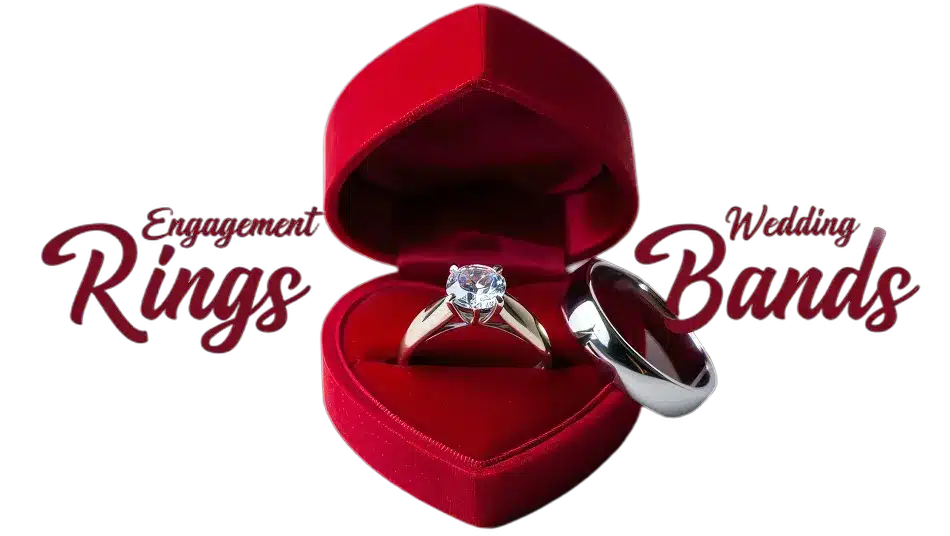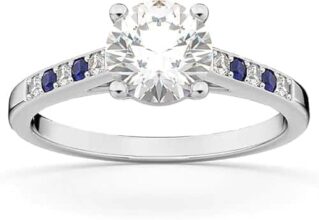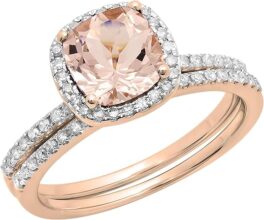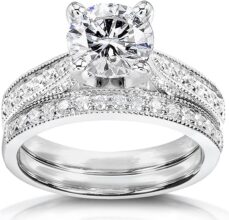
The Journey of Engagement Rings: A Symbol of Love
Engagement rings carry a timeless significance in the journey of love. They represent a promise and commitment that transcends generations. But have you ever wondered about their fascinating history? In this article, you’ll explore the origins of engagement rings, uncovering how they began as simple tokens of commitment.
We’ll journey through time to see how these rings have evolved from modest bands into stunning, elaborate designs. You’ll discover cultural variations that showcase the unique ways people express their love around the world.
As we delve into the rise of diamonds, you’ll learn about how this precious stone became the modern standard for engagement rings. Finally, we’ll discuss personalization and trends, helping you understand how to make your engagement ring uniquely yours. Get ready to unravel the rich tapestry of engagement rings and the love they symbolize!




The Origins of Engagement Rings: A Symbol of Commitment
Engagement rings have a rich and compelling history, tracing back thousands of years. While you might think of a shiny diamond atop a gold band as the archetypal engagement ring, the origins of this tradition are both humble and deeply symbolic. Let’s explore how these rings began as tokens of love and commitment in ancient civilizations.
Ancient Traditions
The concept of engagement rings can be rooted in ancient Egypt, where couples exchanged simple bands made of reed or leather. These rings symbolized eternal love, as circles have no beginning and no end. Moving forward in history, the Romans famously adopted this practice, often utilizing iron for their rings, signifying strength and permanence. They used the engagement ring as a public declaration that a woman was “taken,” a clear way to signify commitment.
Materials and Symbolism
Different civilizations cherished various materials for their rings. For instance, the Romans introduced the idea of inscribing sentimental messages or phrases onto the rings. This personalization indicated not just the bond between the couple but also their social status. Among the wealthier classes, gold became a favored choice, symbolizing prosperity and durability.
The Role of Religion
Religious significance has also played a crucial role in framing the engagement ring’s journey. In Christian traditions, the ring became a symbol of the union blessed by faith, often used during wedding ceremonies to signify a commitment not just to each other but to God as well.
A Contemporary Token
Fast forward to today, and you’ll see that the engagement ring remains a powerful emblem of love. While many modern couples draw inspiration from these ancient practices, the rings today often go beyond the traditional materials and designs. You might even find unique variations, such as Couples Matching Love Pendant Necklaces, that illustrate the versatility of love tokens in contemporary relationships.
As we expand our exploration, it’s fascinating to see how these engagement rings have evolved through the ages, morphing from simplistic expressions of love into extraordinary representations that reflect personal styles and cultural influences. Next, we’ll delve into the evolution of engagement rings and how design has transformed throughout history.
The Evolution Through the Ages: From Simple Bands to Elaborate Designs
Engagement rings have come a long way since their humble beginnings, transforming into stunning symbols of love that often reflect personal style and cultural significance. Let’s take a closer look at how these once-simple tokens evolved into exquisite pieces of art.
The Early Days: Simple Bands
In the earlier centuries, engagement rings were mostly made of materials like leather or iron—basic yet meaningful. The simplicity of these rings carried profound significance, symbolizing a commitment that was straightforward and heartfelt. Just a plain band was enough to express devotion; it was more about the promise than the material itself.
The Medieval Era: Gemstones and Personality
By the medieval period, a shift began to occur as gemstones started adorning engagement rings. Couples began to explore the use of colored stones, making their rings more than just a simple circle. The use of sapphires, rubies, and emeralds became popular, allowing people to express their individuality and social status through their chosen stone.
This era not only elevated the aesthetic appeal of rings but also transformed them into powerful statements representing the wearer’s personality and aspirations.
The Renaissance: Intricate Designs
The Renaissance era brought an explosion of creativity and artistry, and engagement rings were no exception. Jewelers began crafting intricate designs featuring filigree work and elaborate settings. This period saw the emergence of rings that included multiple stones, creating stunning visual effects.
The focus on artistry allowed couples to celebrate their love in truly unique ways, choosing design elements that reflected their stories and shared experiences.
The Victorian Period: Symbolism Takes Center Stage
With the Victorian era came a new wave of symbolism in engagement rings. It was during this time that the language of flowers became popular, and rings began to feature floral motifs. These designs conveyed heartfelt messages and emotions, ensuring that each ring was a deeply personal token of love.
Modernity and Beyond: Integration of Technology
Fast forward to today, and engagement rings fuse beauty with modern technology. Innovations in design techniques, like 3D printing and advanced gem-cutting, have made it easier to create stunning, personalized pieces that cater to individual tastes.
The journey of engagement rings highlights a narrative of adaptability and creativity, ensuring that each piece tells a unique love story. As we continue our exploration, you’ll find that cultural variations enrich this story even further, showcasing the diverse ways in which people express their commitment and love around the world.
Cultural Variations: Engagement Rings Around the World
Engagement rings are not solely a Western tradition; they span across continents, each culture infusing its own style and meaning into these cherished symbols. Exploring these cultural differences not only broadens your appreciation for the engagement ring but also allows you to see the universal themes of love and commitment that bind us all.
The Middle Eastern Traditions
In many Middle Eastern countries, engagement ceremonies include a exchanged rings, but the style and materials used can vary significantly. For example, in countries like Jordan and Egypt, gold rings are often preferred, reflecting the region’s rich history of craftsmanship. It’s common for these rings to feature elaborate designs that symbolize prosperity and status, incorporating intricate engravings or colored stones.
South Asian Customs
In South Asia, particularly in India, engagement rings often play a fundamental role in arranged marriages. Here, the ring is frequently adorned with colored gemstones and intricate details, sometimes reflecting the bride’s family background. It’s also customary for the groom to offer a “pre-wedding” ring, known as a “mangalsutra,” which is deeply symbolic as it denotes the connection to auspiciousness and marital bliss.
East Asian Interpretations
In Japan, engagement rings traditionally incorporate a single diamond that symbolizes purity and commitment. This custom emphasizes simplicity while encompassing deep meaning. However, some modern couples have begun to adopt variations that include colored stones, showcasing personal flair. Similarly, in China, engagement rings are generally more understated, with couples opting for gold bands that can provide a nod to stability and wealth, reflecting societal values.
African Diversity
Africa’s vast cultural landscape brings a wide array of engagement ring traditions. In some cultures, such as among the Zulu people of South Africa, the engagement is marked by a symbolic exchange that doesn’t necessarily include a ring. Instead, beads or traditional items are gifted, emphasizing the importance of family heritage and communal bonds. In contrast, urban areas in Africa may lean towards Western styles, adopting diamond rings for their perceived prestige.
Indigenous Traditions
Indigenous cultures worldwide also lend unique perspectives to engagement traditions. For instance, some Native American tribes use specific stones like turquoise, which symbolizes strength, health, and good fortune. In such customs, the choice of ring or token is often deeply rooted in cultural beliefs and natural elements, reinforcing the connection to their heritage.
Each of these diverse ring customs reflects the beauty in human connection through love, demonstrating that while styles may differ, the intentions remain remarkably similar. As we shift to the next section, we’ll unpack the rise of diamonds into the limelight of engagement rings, illuminating how this precious gemstone became synonymous with love and commitment.
The Rise of Diamonds: The Modern Engagement Ring Standard
As you delve into the enchanting world of engagement rings, one truth stands tall: diamonds have become synonymous with love and commitment. But how did this precious stone rise to its esteemed status? Let’s explore the fascinating journey of diamonds, their enduring allure, and how marketing genius transformed the diamond engagement ring into an unwavering standard.
The Marketing Mastery Behind the Diamond
In the late 19th century, the diamond market took a transformative turn, thanks in large part to De Beers, the diamond mining and trading company. With a brilliant marketing campaign, they turned what was once a luxury item into an essential element of romantic promise. The iconic slogan, “A diamond is forever,” introduced in 1947, successfully positioned diamonds not just as gems but as the ultimate symbol of eternal love.
Imagine walking through a jewelry store filled with colorful gemstones and intricate designs, but it’s the sparkling diamond that catches your eye—it’s hard to resist! This emotional appeal changed consumer behavior, making diamonds the must-have centerpieces in proposals and engagements.
Decoding the ‘Four Cs’: A Guide to Diamond Quality
If you’re considering a diamond engagement ring, understanding the ‘four Cs’—Carat, Cut, Color, and Clarity—is essential in making an informed choice:
Understanding these characteristics can help you find a diamond that resonates with your taste and budget, ensuring that you select a ring as unique as your love story.
Contemporary Trends in Diamond Rings
The diamond ring market continues to evolve, with trends such as lab-grown diamonds gaining popularity. These ethically sourced stones offer brilliant alternatives and can often fit a more budget-friendly option without sacrificing quality. You might even find that couples are increasingly choosing personalized settings to showcase their unique stories, incorporating vintage designs and even colored diamonds for a splash of individuality.
The rise of diamonds as the modern engagement ring standard is a testament to our evolving expressions of love and commitment. As you immerse yourself in this sparkling world, the next section will reveal how cultural variations shape the narrative of engagement rings around the globe, enhancing your appreciation for this beautiful tradition.
Personalization and Trends: Making Your Engagement Ring Unique
As the world of engagement rings continues to expand and evolve, personalization has become a significant trend that allows couples to express their love stories authentically. Instead of sticking to traditional designs, many people explore options that resonate with their personal aesthetics and shared experiences. So, how can you navigate this exciting landscape and find a ring that truly reflects your relationship?
Unique Gemstones: Beyond Diamonds
While diamonds remain a classic choice, there’s a whole spectrum of gemstones that offer vivid colors and meanings. Think outside the traditional diamond box, and consider gems like:
Choosing a unique gemstone can encapsulate the essence of your relationship. For example, if you both met during a trip to the beach, an ocean-blue topaz might evoke those sweet memories every time it catches the light on her finger.
Custom Designs: A Personal Touch
Another avenue for personalization is custom jewelry design. Many jewelers now offer bespoke services, allowing you to collaborate on a unique piece. Do you want a band that mimics the twist of a vine, representing your growth together? Or perhaps an intricate vintage-style setting that pays homage to the past? By working directly with a jeweler, you can create a ring that is genuinely one-of-a-kind.
This is where stories intertwine; for example, a couple I know designed a ring that included elements symbolizing their favorite places and memories—from a hidden cove to the city skyline where they had their first date. It turned a simple ring into a profound emblem of their journey.
Trending Styles: Embrace the Unexpected
Current trends favor bold, unexpected styles that cater to individual tastes. Some couples favor:
These trends encourage you to think creatively. Consider how you can blend various styles or incorporate personal symbols to ensure the ring narrates your unique love story.
Seek Inspiration
Don’t shy away from exploring inspirations on platforms like Pinterest or Instagram. Seeing how others have personal preferences can spark creativity and guide your choices. Whether it’s unusual stone settings or inscribed messages, these platforms offer endless ideas.
Ultimately, the journey of choosing an engagement ring is as unique as your relationship. Every decision—from choosing gemstones to the ring’s design—offers a significant opportunity to reflect your shared values and future aspirations. As we look further, we’ll explore how this timeless symbol continues to be defined and celebrated in various ways across cultures, reinforcing the profound bond that engagement rings signify.
The Timeless Symbol of Love
To wrap up, it’s clear that engagement rings have transcended mere adornment to embody deep emotions and commitment. As you’ve explored their fascinating journey from ancient symbols to modern masterpieces, you may find yourself appreciating how each ring tells a unique story — yours.
Whether you opt for a classic diamond, a personal touch, or a cultural homage, your choice reflects not just your love, but also your identity and values. So, as you embark on this exciting journey of love, remember that the engagement ring serves as a cherished reminder of your bond, a timeless symbol of the promise you make to one another. Embrace this journey, and let your ring be a testament to your unique love story.








